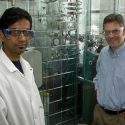Potent toxin reveals new antibiotic resistance mechanism
One of the great frustrations of modern medicine is the creeping ability of pathogenic microbes to develop resistance to the antibiotics we throw at them.
More and more, microbes are able to eliminate, modify and sequester the toxic molecules that make up the arsenal of antibiotics that humans use to treat infection, making once-miraculous drugs increasingly impotent. Now, adding to the mix of devices dangerous microbes deploy to evade destruction by antibiotics, scientists have discovered another way pathogens escape from the most potent drugs: self-sacrifice.
It is the equivalent of the courageous soldier throwing himself on a grenade, says Jon S. Thorson, a UW–Madison professor of pharmacy and the senior author of a paper describing the newfound method of antibiotic resistance published in the Sept. 12 edition of the journal Science.
“It is a new paradigm for resistance,” says Thorson. “It points to the fact that bacteria continue to find new routes to evade these drugs.”
The discovery was made by Thorson and colleagues John B. Biggins and Kenolisa C. Onwueme of the Sloan-Kettering Division, Joan and Sanford A. Weill Graduate School of Medical Sciences, Cornell University Cancer Center. Biggins is now at the UW–Madison School of Pharmacy.
The new finding was made using a highly potent anticancer agent known as an enediyne. Enediynes are a class of anti-tumor antibiotics that work by shredding DNA and disrupting the ability of a cell – such as cancer cell or a unicellular organism like a bacterium – to function and reproduce. They rank among the most potent naturally occurring antibiotics, and only a few molecules are required to destroy a cell.
In nature, soil bacteria use enediynes to create a buffer, a very localized environment free from competing microbes, which could overwhelm the slow-growing enediyne-producing bugs. But to survive in the toxic environment it creates, the microbe must have a way to survive its own poisons.
This is especially true, Thorson says, if one of the toxic molecules a bacterium secretes is soaked up by the bacterium itself. To protect itself, the bacterium quickly deploys a protein that intercepts the misdirected enediyne before it finds and destroys the organism’s DNA.
“Instead of cleaving DNA, the enediyne cleaves the protein and thereby inactivates itself,” says Thorson. “By detonating its ‘warhead’ to cleave the protein instead of the DNA, the cell is preserved. It’s somewhat inefficient, but at least the cell survives.”
Over time, many antibiotic-producing microbes have evolved a variety of ways of not succumbing to the toxins they use to keep competitors at bay. But these methods of evading their own chemical warfare agents tend to be shared among bacteria, says Thorson, and are at the root of antibiotic resistance among the pathogenic bacteria that also borrow the defense mechanisms.
Scientists have long known that bacteria can thwart antibiotics by rearranging their chemistry to keep a drug from binding to a cell. What’s more, bacteria have learned how to clean house by quickly pumping antibiotic molecules out of affected cells. They also have acquired the trick of making molecular ‘sponges,’ proteins that bind to antibiotics and take the drugs out of the game before they can do their lethal work.
The new mechanism found by Thorson’s group does not bode well for the fight against dangerous and sometimes deadly bacteria.
“Many of our drugs are coming from soil bacteria like these,” Thorson says referring to the enediyne-producing bacteria with which he works. “This is the first known example of this kind of self-sacrifice mechanism for resistance. It points to the fact that bacteria continue to find new routes to evade these (antibiotic) molecules.”
It would be surprising, Thorson argues, for this new mechanism to be unique to the enediyne-producing bacteria.
“One of the questions we’ve asked ourselves is, ‘[Is] this a once-in-a-blue-moon discovery – or will this mechanism be found in other organisms?’ Since nature usually sticks with what works, I would not be surprised if we see this mechanism pop up again.”
The work conducted by the Wisconsin team was funded in part by the National Institutes of Health.
Tags: biosciences, research



